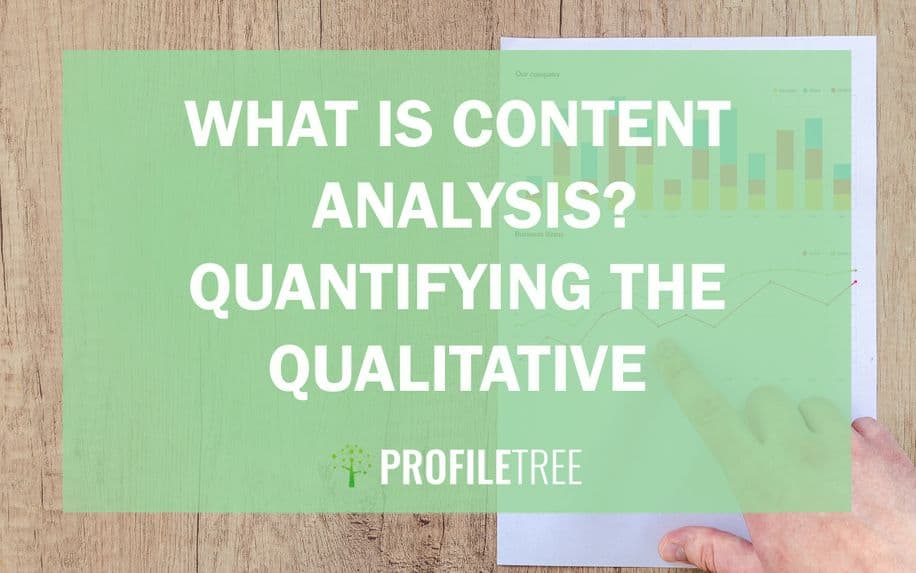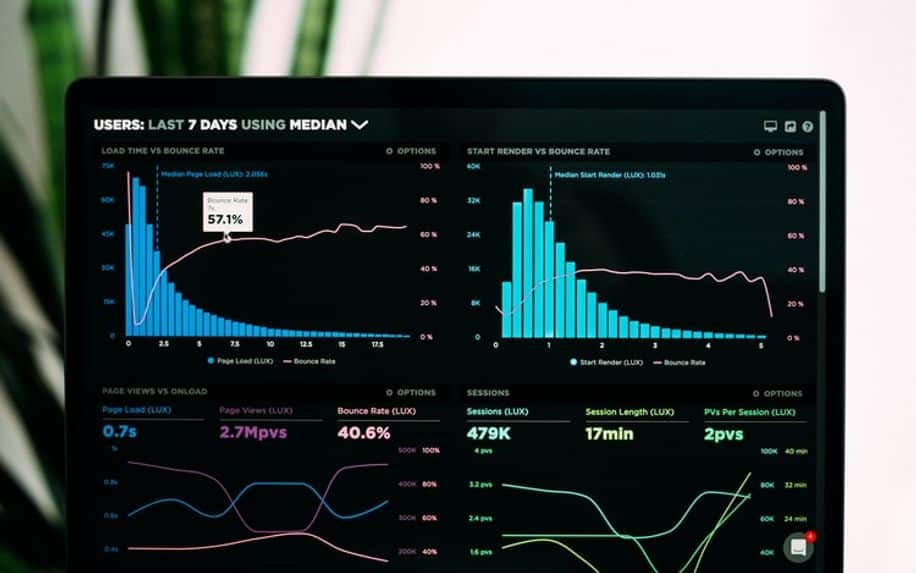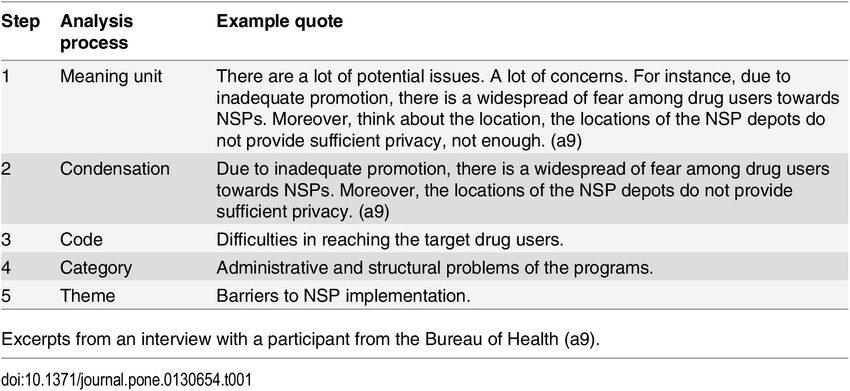Content analysis is a versatile research method that can be applied in various fields such as communication studies, sociology, psychology, marketing, and information science. It’s an important method of research and the results gathered can provide real strategic insights.
Content analysis as a research method, provides lots of in-depth detail on the meanings behind responses. It gets into the nitty-gritty details and explores the respondent’s interpretations and opinions. It is a qualitative research method, however, the data can be quantified, making it a suitable method for both forms of research.
In this article, we’ll explore how valuable content analysis is as a research method and how you can implement a content analysis study. We’ll give you lots of helpful tips and tricks so that you can gain the most out of your content analysis.
Table of Contents

Content Analysis Definition
Content analysis is a research method used to identify patterns and themes within qualitative data. It involves coding and categorizing information to provide a systematic and objective means of describing and quantifying phenomena. This method is commonly used in social sciences to study communication and media content, but it can also be applied in various other fields such as marketing.
Content analysis is used to understand the individual, group, or other forms of social communication. It can help researchers understand social reality, the cultural context, or the historical impact from the respondent’s perspective. Content analysis is also useful for analysing many different sources of information, including texts, interviews, surveys, images, and media messages – making it a versatile method for research.

Explain content analysis in a few sentences
Content analysis is a qualitative research method. It seeks to understand the ‘why’ behind responses, gaining in-depth detail and understanding. This form of research method can be used to analyse interviews, audio clips, video content and even text formats such as diaries. The goal is to extract meaningful information from the content in order to understand the context, message, and implications of the communication. It can almost be explained as a bridge between qualitative understanding and quantitative measurements.
What is Content Analysis?
In short, to answer the question: what is content analysis – it is a method used for describing written, verbal or graphic communications.
Content analysis is a widely used research process. In simple terms, it is a method of research that changes qualitative data into quantitative figures. This is done by making accurate understandings through reading and coding the qualitative data.
- Qualitative data may include documents, texts or even oral communications.
- Texts are assigned labels to show if there are any important patterns within.
- By using labels, the content is analysed, providing a quantitative overview of qualitative data.
Analysing content helps in the study of many challenging topics of interest to researchers. This may include organisational behaviour strategy, managerial reasoning, human resources, technology and innovation management, as well as international management.
Content analysis can help close the gap between research with large sample sizes and research with smaller sample sizes. Small sample research can help in collecting primary data as well as in-depth analyses, however, it may suffer from external credibility problems. On the other hand, a large sample size may have internal validity issues and lack deeper meaning. Therefore, content analysis will help in improving the quality of the research by considering the benefits of both the small and large sample size research.
Content Analysis Approaches
Content analysis has three main approaches: conventional, directed, and summative. All methods are similar in their major aim – which is to understand the meaning of a text from its content.
Conventional Content Analysis
Conventional content analysis is commonly used where a study’s main intention is to appoint a certain incident. It is usually applied when research on the topic is limited.
- When using conventional analysis, researchers don’t use fixed categories. Instead, they let the categories and their labels flow from the literature. They may also engage themselves in the data to allow new observations to develop.
- The process is as follows: first, data is analysed generally by reading all information together. This is done in order to promote engagement and gain a sense of the whole idea.
- The data is read again, but this time it is prepared word by word. This step involves first highlighting specific words from the information that seem to display crucial concepts.
- The researcher then makes notes of any patterns, thoughts, and initial understandings – this is done with the aim of developing codes.
- Throughout the content analysis process, labels for codes are made that reflect the main thoughts of the data.
- After that, codes are organised into groups and the grouping system is done based on how codes relate to each other. The main aim of this part is to group codes into meaningful clusters.

Directed Content Analysis
The researcher would choose a directed approach to content analysis when previous incomplete research about the incident is available. The main objective of using a directed approach is to help the researcher create further developments – where prior research would help.
Prior research will support the development of the research question and provide predictions about the key variables and the links between them. As a result, this can help in finding the first coding scheme.
- The process of using a directed approach is more organised than using a conventional approach.
- It starts by identifying the main variables as initial coding categories, and then operational definitions for each category are determined.
- Based on the research question, data and the researcher’s goals, labelling/coding can follow two main strategies.
- First strategy: If the research objective is to classify and sort all cases of the incident, then reading and highlighting all of the data that seems to represent the needed reactions is considered the best solution.
- The researcher will label all highlighted information by the initial codes. Any data that could not be coded from the coding scheme would be given a new code.
- Second strategy: This method can be used in directed content analysis starting with immediate labelling using the predetermined codes. In this case, the researcher is confident that initial coding will not bias the action of picking out relevant text.
- Through the process, information that could not be given code is recognised and analysed later to decide if it represents a new category in the coding scheme.

Summative Content Analysis
A study using a summative approach begins with organising and counting specific words in the data. The main objective of this step is to investigate the usage of specific words, instead of trying to understand the meaning of the content.
This type of analysis is also known as manifest content analysis. If the process ends at this step, the analysis would be considered as quantitative analysis. However, a summative method’s main goal is to discover underlying data meaning by quantifying words.
- The process of a summative approach starts with counting the occurrences of specific words. This can be done either by manual counting or by computer.
- Quantifying words in data can help in identifying patterns as well as inspecting the codes. It also helps in understanding the text in terms of the specific words used.
- A summative approach has various advantages. It is a subtle method to explore the concerned aspect and perhaps the most straightforward. It can also deliver simple insights into the usage of certain words for better understanding.
- On the other hand, this approach has some drawbacks; the results using this method are limited to the extensive meanings within the data, and may perhaps miss out on other important data points.

Differences Between the Approaches
There are many major differences between the three approaches to qualitative content analysis, particularly in terms of coding systems, the origins of codes, as well as threats to credibility. Some important points that are worth considering include:
- The conventional content analysis develops the labelling system directly from the text documents. However, during the analysis of a directed method, the process already starts with relevant research results, which serve as guidance for initial coding.
- A summative content analysis will count and compare keywords or content, however, this may disregard the context/meaning behind the responses, which invalidates the qualitative side of the research method.
Understanding each approach in full detail is a significant matter to researchers. This is mainly to identify which method will work best in their study of interest.
Content analysis will basically develop a quantitative description that comes from a qualitative one. This helps researchers in studying, developing and furthering knowledge in other areas.
There are three types of content analysis that could be used in a study; conventional, directed, and summative. Different research designs and analysis are used depending on the objective and the research available.
Content Analysis Research Example
Check out this example of using content analysis as a research method.
Title: “Representation of Women in Popular Music Lyrics Over the Last 50 Years”
Objective: To understand how the portrayal of women in popular music lyrics has changed over the past five decades.
Method:
Data Collection
The researcher would first collect lyrics from popular songs from each year over the past 50 years. The songs could be selected based on their chart performance or cultural impact.
Coding
The researcher would then develop a coding system to categorise the lyrics. Categories could include themes such as love, power, objectification, independence, etc. Each song would be analysed and coded based on these categories.
Analysis
The coded data would then be analyzed to identify trends and patterns. For example, the researcher might look at whether songs are more likely to portray women as independent or objectified, and how these portrayals have changed over time.
Results
The results of the study would provide insights into the changing portrayal of women in popular music and could contribute to broader discussions about gender representation in media.
Remember, this is just one example. Content analysis can be used in a wide range of fields and for various types of research.
Content Analysis Table
Check out this basic example of what a content analysis table might look like. Please note that the actual table would depend on the specific research question and the coding scheme used.

In this example, you can see how the data is condensed and categorised into different themes. This is a very basic example. In a real content analysis, the table might be more complex, with multiple columns for different variables, and it might include percentages or other statistical measures. The table would also be accompanied by a narrative explanation of the findings.
Content Analysis Social Media
Social media is a great resource to use in order to collect data for content analysis. It can also be thought of as a more truthful resource to use, as people are offering their unfiltered opinions and not influenced so much in that they are being studied.
Here’s a general guide for using content analysis on social media.
Define Your Goals
Before you start, it’s important to know what you’re looking to achieve with your analysis. Are you trying to understand the sentiment towards your brand? Are you looking to identify common themes or topics in your industry? Your goals will guide your entire analysis process.
Identify Your Data Source
Decide which social media platforms you’ll be analysing. This could be one platform or multiple, depending on your goals and where your audience is most active. Suggestions include Facebook, Instagram, LinkedIn, Pinterest and Twitter.
Collect Data
Use social media analytics tools to collect posts, comments, and other forms of content for analysis. You might collect data over a specific time period, or you might collect a certain number of posts.
Develop a Coding Scheme
Decide what aspects of the content you’ll be analysing. This could include the sentiment of the content (positive, negative, neutral), the topics discussed, the presence of certain keywords, etc. Each piece of content that fits into these categories will be “coded” accordingly.
Code the Content
Apply your coding scheme to the content. This can be done manually, but for large volumes of data, you might use text analysis software or other tools. Colour coding is also a great way to help you visualise the data.
Analyse the Results
Once your content is coded, you can analyse the results. This might involve calculating the percentage of posts that fall into each category, identifying trends over time, or comparing results between different social media platforms.
Interpret and Report
The final step is to interpret your results and report your findings. This could involve writing a report, creating a presentation, or simply sharing your insights with your team.
Remember, social media content analysis can be a complex process, and it requires careful planning and execution. But with the right approach, it can provide valuable insights into your audience, your brand, and your industry.
Content Analysis Psychology
In psychology, content analysis is a widely used qualitative research technique to analyse textual, visual, or auditory content. It allows researchers to understand human behavior, thoughts, and emotions by examining communication patterns, themes, and meanings within a given set of data.
Here’s how it is applied in psychology:
1. Understanding Human Behavior
- Psychologists use content analysis to study verbal and non-verbal communication, written texts, media content, or visual symbols to gain insights into human behavior, social norms, and cultural patterns.
2. Thematic Analysis:
- Thematic analysis is a common form of content analysis in psychology, where researchers identify, analyse, and report patterns or themes within the data. It helps in understanding the underlying meanings and concepts in the content.
3. Studying Mental Health:
- Content analysis is used to study the narratives of individuals with mental health conditions, analysing their communication patterns, expressions of emotions, and coping mechanisms.
4. Social Media and Online Behavior:
- Psychologists analyze content from social media platforms, forums, and online communities to study online behavior, cyberbullying, mental well-being, and the impact of digital communication on psychological health.
5. Analyzing Therapeutic Sessions:
- Transcripts of therapy sessions can be analyzed to understand the therapeutic process, client-therapist interaction, and the effectiveness of different therapeutic approaches.
6. Examining Media Representations:
- Content analysis is used to study the representation of mental health, gender, race, and other social issues in media, examining stereotypes, biases, and societal attitudes.
7. Developmental Psychology:
- Researchers analyse children’s drawings, narratives, and play behaviour to understand developmental stages, emotional expression, and cognitive development.
8. Coding and Reliability:
- In content analysis, developing a reliable coding scheme is crucial. Psychologists ensure inter-coder reliability and validity to make accurate and generalizable inferences.
While content analysis can be quantitative (frequency of words, phrases, or themes), it also provides qualitative insights into the depth and complexity of psychological phenomena.
Content Analysis Sociology Definition
In sociology, content analysis is defined as a systematic and objective research method used to analyse textual, visual, or auditory content. The goal is to identify patterns, themes, biases, and meanings within the content to understand social phenomena, cultural norms, societal structures, and human behavior.
Content analysis in sociology is employed to study a wide range of subjects, including media representations, social discourse, institutional documents, and individual communications.
Applications in Sociology
Content analysis can be quite useful from a sociological perspective, here are some ways that it can be used below.
- Media Studies:
- Analyzing representations of gender, race, class, and other social categories in media to understand societal norms and biases.
- Social Discourse Analysis:
- Examining public discourse, political speeches, and social media communication to study social ideologies, power relations, and societal values.
- Institutional Analysis:
- Investigating institutional documents, policies, and regulations to understand organizational structures, practices, and norms.
- Cultural Studies:
- Exploring cultural texts, artefacts, and symbols to understand cultural meanings, identities, and practices.
Content Analysis Advantages
Content analysis offers several advantages as a sound research method, check them out below.
Objectivity and Reliability
Content analysis allows for a high degree of objectivity as it involves systematic procedures that any researcher can replicate. This enhances the reliability of the findings.
Large Sample Sizes
Content analysis can handle large volumes of data, making it suitable for studies that involve extensive text or image-based sources.
Unobtrusive
As a non-reactive, unobtrusive method, content analysis does not affect the content being analyzed, which can be a significant advantage over other research methods that may influence the subject’s behaviour.
Longitudinal Analysis
Content analysis allows for longitudinal studies as it can analyse messages and content from the past and present, making it possible to identify trends and changes over time.
Versatility
Content Analysis can be applied to a wide variety of fields and disciplines, and it can analyse different types of data, including texts, images, audio, and video.
Cost-Effective
Compared to other research methods like surveys or experiments, content analysis can be less expensive as it often involves analyzing existing data that is available to the researcher.
Provides Valuable Insights
It can reveal trends, patterns, and themes that might not be immediately apparent, providing valuable insights into the content’s context and meaning.
Remember, while content analysis has many advantages, it also has limitations and should be used in conjunction with other methods to ensure a comprehensive understanding of the research subject.
Content Analysis Disadvantages
While content analysis has many advantages, it also has some limitations as a research method.
Subjectivity
Although content analysis is supposed to be objective, the coding process can be subjective as it depends on the coder’s interpretation. This can lead to bias if not carefully managed.
Lack of Depth
Content analysis often focuses on the frequency of specific words or concepts, which may overlook the context or the deeper meaning behind the content. Researchers should opt for more qualitative methods in order to uncover meanings.
Time-Consuming
Depending on the volume of data, content analysis can be time-consuming, especially if the data needs to be coded manually. This makes it a difficult process, especially if using a large sample size.
Limited by Available Content
The analysis is limited to the content that is available and accessible to the researcher. Some content may be unavailable, censored, or lost, which could influence the findings of a project.
Overemphasis on Quantification
In trying to quantify data, there’s a risk of oversimplifying or misinterpreting the data. The richness of qualitative data may be lost when it’s transformed into numerical data, taking away from the true findings of the study.
Requires Clear and Relevant Categories
The effectiveness of content analysis depends on the clarity and relevance of the categories used for coding the data. Poorly defined categories can lead to unreliable results and skewer the project’s findings.
Lack of Theoretical Framework
Content analysis is often criticized for its lack of a theoretical framework. It’s a tool for analysis, but it doesn’t provide explanations or theories about why the content is the way it is.
Despite these limitations, content analysis can still provide valuable insights when used appropriately and in conjunction with other research methods.
Depending on your research study, you schedule evaluate these advantages and disadvantages and select the most appropriate method for reliable and trustworthy results.
Content Analysis Software
Manually coding content can become quite time consuming, luckily, there are different types of software available to make the process a lot easier.
- NVivo:
- NVivo is a widely used qualitative data analysis software that supports text, audio, video, and image data. It offers features like coding, text queries, word frequency analysis, and visualization tools.
- ATLAS.ti:
- ATLAS.ti is a powerful tool for qualitative research, supporting a wide range of data types. It allows for coding, annotation, and visualization, helping researchers uncover complex patterns and relationships.
- MAXQDA:
- MAXQDA is a versatile software for qualitative and mixed-methods research. It offers features like coding, memo writing, text analysis, and visualization tools for both textual and multimedia data.
- Dedoose:
- Dedoose is a web-based application for mixed-methods research. It offers features like code application, data charting, and export options, making it accessible and collaborative.
- Quirkos:
- Quirkos is a user-friendly qualitative analysis software that helps researchers sort, manage, and understand text data. It offers visual and interactive features for coding and exploring themes.
- Leximancer:
- Leximancer is an advanced content analysis software that uses AI to automatically identify themes, concepts, and sentiment from text data. It offers visualization tools like concept maps.
- RapidMiner:
- RapidMiner is a data science platform that offers text mining and analysis capabilities. It supports various text processing techniques, including tokenization, stemming, and sentiment analysis.
- WordStat:
- WordStat is a text analysis software that offers features like content analysis, text mining, and sentiment analysis. It can analyze large datasets and generate detailed reports.
- KH Coder:
- KH Coder is a free and open-source software for quantitative content analysis and text mining. It supports various statistical analyses and visualization methods.
- TAMS Analyzer:
- TAMS Analyzer is a free and open-source tool for qualitative research on macOS. It offers features like coding, annotation, and reporting.
When choosing content analysis software, consider factors like the type of data you are analyzing, the features you need, your budget, and the software’s ease of use. Additionally, ensure that the software supports the methodological approach of your content analysis.
How to perfect your content analysis technique
Perfecting a content analysis technique requires practice, understanding, and refinement over time. Here are some steps to help you improve your content analysis skills.
- Clear Objectives: Define clear and specific objectives for your content analysis. Knowing exactly what you want to find out will guide your coding process and help you stay focused.
- Comprehensive Coding Scheme: Develop a comprehensive and relevant coding scheme. Your codes should cover all possible aspects of the content that are relevant to your research question.
- Pilot Testing: Before you start the actual analysis, do a pilot test with a small subset of your data. This will help you identify any issues with your coding scheme and make necessary adjustments.
- Multiple Coders: If possible, use multiple coders to analyze your content. This can help reduce bias and increase reliability. After coding, you can calculate inter-coder reliability to ensure consistency among coders.
- Regular Reviews: Regularly review and refine your coding scheme as you progress with your analysis. You might discover new themes or patterns that were not apparent at the start.
- Use of Software: Consider using qualitative data analysis software. These tools can help you manage and code your data more efficiently, and they can also assist with the analysis and visualization of your results.
- In-depth Analysis: Don’t just count the frequency of codes. Look for patterns, relationships, and trends in the data. This will provide a deeper understanding of your content.
- Interpretation: Always relate your findings back to your research objectives and the existing literature. This will help you draw meaningful conclusions from your analysis.
- Documentation: Keep detailed records of your coding process and your decisions. This enhances the transparency and replicability of your study.
Remember, content analysis is a skill that improves with practice. Don’t be discouraged if your initial attempts are not perfect. Keep refining your technique, and don’t hesitate to seek feedback from others.


